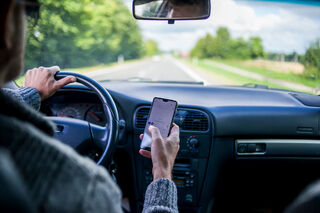Mindfulness
Distracted Driving Is Deadly, Learn How to Prevent It
Research tells us what activities are the most distracting.
Posted February 1, 2022 Reviewed by Lybi Ma
Key points
- Distracted driving leads to accidents and injuries every day.
- Anything that takes your mind off of the road is considered distracted driving.
- There is some evidence that practicing mindfulness can help people to avoid distracted driving.

Distracted drivers kill eight people each day in the U.S. on average. While this is a problem that involves everyone, young people are disproportionately at fault. About 25 percent of the distracted drivers involved in fatal crashes are in their 20s, and teen drivers are even more likely to be involved in a distracted driving accident.
A large body of evidence describes what’s going on and how we can fix it. According to the Centers for Disease Control and Prevention, there are three ways people become distracted while driving: taking their eyes off the road, taking their hands off the wheel, or taking their mind off of driving by thinking about something else.
A 2018 systematic review found that any conversation – whether using a handheld phone, a hands-free device, or conversing with a passenger in the car – led to a reduction in driving performance. The review, published in the journal Human Factors, included 93 studies with more than 4,300 participants. Researchers found that most drivers conversing on a cellphone while driving compensated for their distraction by reducing their speed and leaving more space for the vehicle in front of them.
The review also found that dialing a phone led to greater reductions in performance compared to simply talking, and therefore was much more dangerous. One takeaway: If you are planning to have a phone conversation while driving, dial before you begin your trip.
A more recent study published by researchers in China last year looked at the effect of voice-activated, hands-free driving apps on youth drivers. Their experiments found that these apps significantly weakened the performance of young drivers. Specifically, young drivers using these apps were more likely to drift from side to side within their lane, had slower response time (especially when a traffic light changed color), and were more likely to experience a collision.
And it’s not just driving. A 2018 review found that when young people use mobile phones while walking and biking, they also make riskier choices. Pedestrians distracted by phones waited significantly longer to cross a road, missed more opportunities to cross safely, and crossed more slowly. Both adults and children using a phone while riding a bike were able to compensate by reducing their speed or stopping. But there is some evidence that using a phone while biking delayed response times and led to less head movement, or looking around for dangers.
There is a lot of data that suggest phones lead to unsafe interactions while we are traveling. What can we do about it? A systematic review from 2019 looked at whether a specific type of intervention can reduce distracted driving: mindfulness training. Researchers analyzed 17 studies that looked at whether having a mindful mentality improved driving behaviors, and whether specific mindfulness interventions could help.
They found that when a driver’s mind wanders, they are more likely to overlook hazards, make mistakes, and increase their risks of having a collision. In addition, they found some limited evidence that mindfulness exercises before or while driving, such as taking slow deep breaths, may help drivers stay focused and avoid using mobile or hands-free devices while driving. More research is needed to ensure that these strategies actually work.
The takehome message: Anything that takes your mind off the road while driving increases the chances you’ll make a mistake and get involved in a collision. This is especially true for new drivers and young adults. The best strategy to avoid distracted driving is to make a concerted effort to stay in the moment and pay attention to your surroundings.


